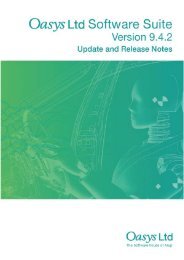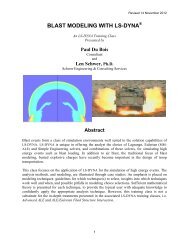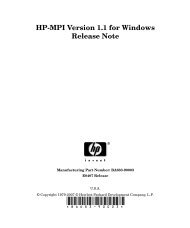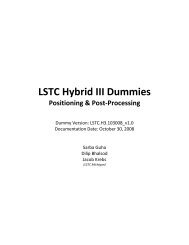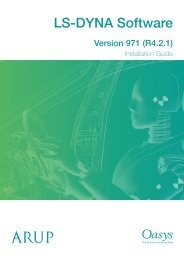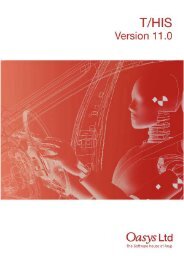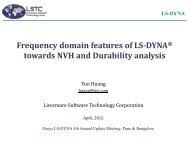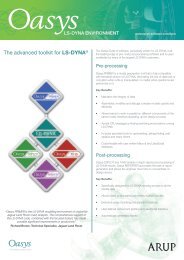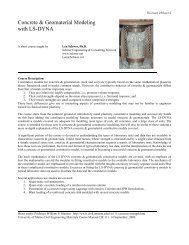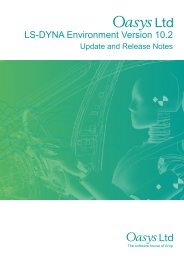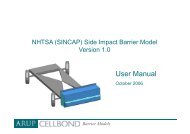Oasys LS-DYNA Environment 8.1 VOLUME 3 ... - Oasys Software
Oasys LS-DYNA Environment 8.1 VOLUME 3 ... - Oasys Software
Oasys LS-DYNA Environment 8.1 VOLUME 3 ... - Oasys Software
Create successful ePaper yourself
Turn your PDF publications into a flip-book with our unique Google optimized e-Paper software.
<strong>Oasys</strong> <strong>LS</strong>-<strong>DYNA</strong> <strong>Environment</strong>: User Guide (Version <strong>8.1</strong>)<br />
How to Restart an Analysis<br />
The restarting process is simple. Enter the OASYS command shell, submit the job and opt for<br />
restart when the menu appears. You will be asked to select which dump file to restart from; the<br />
available dump files are listed with the analysis times at which they were created.<br />
Restart Input Files<br />
A restart input file is needed only if changes are to be made to the model. There are three cases;<br />
! No restart input file. The analysis will continue unchanged.<br />
! Short restart input file.<br />
! Full deck restart input file (see separate notes below).<br />
The short restart input file must be created by hand; keyword style can be used, and it is<br />
necessary to create keyword cards only for those items to be changed. Section 28 of the keyword<br />
manual lists the available keywords.<br />
An example of a short restart input file is given in Appendix B, Example 8.<br />
The naming convention for short restart input files is as follows:<br />
analysis_ralph_1.key - keyword file for original analysis<br />
analysis_ralph_1.key01 - restart input file for first restart<br />
analysis_ralph_1.key02 - restart input file for second restart.<br />
The naming convention is important because it allows the oasys command shell to find the<br />
correct file.<br />
The "restart number" is governed by which analysis wrote the restart dump from which the restart<br />
takes place: e.g. if we are restarting from analysis_ralph_1.dpf03, and this file was<br />
written by the original analysis, then the restart is by definition the first restart (or restart 1). If<br />
the first restart writes more restart dump files, including analysis_ralph_1.dpf05, then<br />
any restart analysis using analysis_ralph_1.dpf05 as a starting point is by definition the<br />
second restart (or restart 2).<br />
Effect on Output Files<br />
Binary output files (.pft, .ctf, .thf and .xtf) are joined seamlessly at the time of the restart. There<br />
is no way of telling which output states were produced by the original analysis and which by the<br />
restart analysis. For restarts which began from a point part-way through the original analysis, the<br />
restart analysis overwrites the original results from that point.<br />
New ASCII output files are started for each restart: root_name.otf01 and<br />
root_name.log01 for the first restart, etc.<br />
Page 3.4



